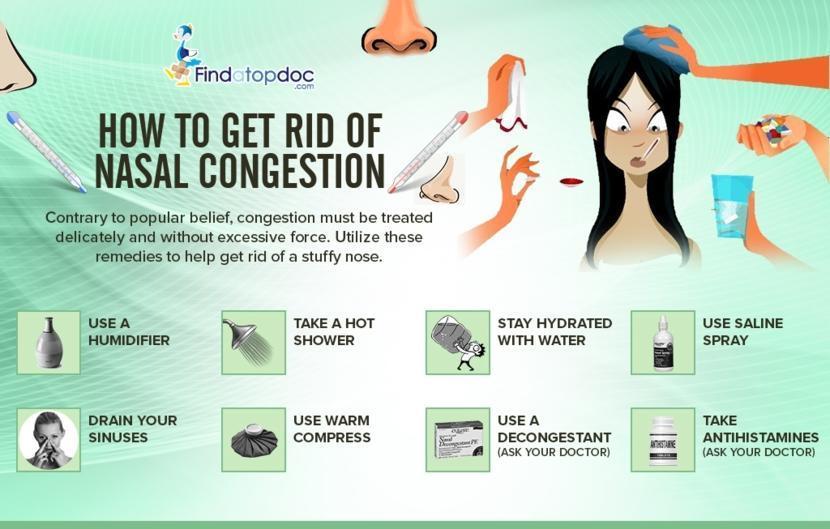Are There Specific Causes of Nasal Congestion?

We all undergo this feeling when the nose becomes blocked with mucus, making it difficult to even breathe. The feeling is very irritating, as with it comes a number of other secondary symptoms. There are various reasons behind nasal congestion, including the pressure on the sinus points. Some of these reasons include colds, the flu, and allergic reactions. The reasons can be many, but the effect is the same. The symptoms can really get to a person, eventually leading to a lot of fatigue and pain throughout the body.
What Causes Nasal Congestion?
The stuffed up feeling that you can get in your nose when you have a cold or an allergy is mainly caused by the inflammation of the tissue lining that resides in your nasal passages. The inflammation eventually triggers irritation of the membranes in your nasal passage. Due to this, there is more mucus production in your nasal cavity, which leads to the clogging of nasal passages, resulting in nasal congestion.
Nasal congestion is most often accompanied by mucus discharge, also referred to as a runny nose; however, sometimes there may be no discharge, which causes a worse feeling of a dry stuffy nose.
Nasal congestion is not only common in adults but also in kids and infants. In fact, when nasal congestion hits infants, it causes worse symptoms, as it disturbs their sleep, and breastfeeding children may even find it difficult to take their feed. The bigger trouble with infants is that they are unable to blow their noses to get relief from the congestion, which leaves them to suffer the congestion for a longer period of time.
There are various causes that can be attributed to nasal congestion; there are four main causes. A number of patients could face just one of these causes, resulting in nasal obstruction, while some of them could be facing a combination of them. Some of the primary causes include:
An Infection
On average, it is normal for any adult to get about two or three bouts of the common cold in the span of a year. Viral infections are a normal occurrence at a young age when the immunity is building. In fact, at a younger age, one would get these cold and cough episodes more often, which decrease as one grows older. A cold is triggered by one or more viruses, a number of which could be airborne. However, most of these viral infections are contracted by direct contact. The hands carry these viruses by touching one or more infected places and when they touch the nose, the cold virus is transmitted. Once the virus reaches the nose, it gets absorbed by the nasal passage, and the body, as a result of the virus, releases histamine. Histamines are chemicals released by the body in response to a trigger that increases the blood flowing to the nose, causing inflammation of nasal tissues or membranes. The swollen tissues in the nasal passage get clogged with blood and in turn secrete huge amounts of mucus that causes congestion in the nasal airways. Medicines like antihistamines and decongestants are often prescribed to relieve cold symptoms that are a result of an infection; however, this is not immediate and takes its own due course of time.
Structural Deformities
Sometimes there are inherent abnormalities or deformities found in the nose and the septum. The septum is the bone that separates the two nostrils. These abnormalities could be present from birth or due to certain injuries. Almost 7% of babies could suffer from nasal injuries during the delivery. Nasal injuries could happen to anyone, including both kids and older people. In case the injury begins to hamper breathing, a corrective surgery may be recommended to relieve the congestion.
Enlargement of the adenoids, a type of tissue situated in the nose, is one of the common causes identified for nasal congestion in children. Those suffering from this condition could have complaints at night, such as breathing with a whistling sound or snoring. Kids used to breathing heavily from their mouth can have other secondary conditions that could affect their face or teeth. In severe cases, the adenoids can be removed through a surgery, if felt necessary by the doctor. Other forms of deformities includes tumors and other forms of growths. Little kids often end up inserting small or sharp objects in their noses, which could result in an injury.
Other causes in this category include nasal tumor and foreign bodies. Children are often known to insert small objects into their noses. In case the discharge from the nose smells bad, then the condition may require some medical intervention.
Different Allergic Triggers
A number of cold and cough conditions are triggered by various allergies. Colds triggered by allergic reactions have various names, like hay fever, rose fever, etc. An allergic reaction is caused by an inflammation that occurs as a response of the body to an allergen. This substance that triggers the allergy could be a food item or anything present in the environment, like dust, pollen, animal dander, or molds. People who are allergic to various substances could face congestion and a runny nose as a result of the allergy. Some of the common antihistamines include Benadryl, Zyrtec, Allegra, Alavert, and so on. These are available at a pharmacy without a prescription; however, it is always better to consult your treating doctor before consuming any medications.
To treat the allergies, allergy shots are often administered to patients. There are certain tests, like the SLIT skin test and blood tests, that are used to draw out the profile of the individuals, which further determines the course of treatment. Once a person is given an allergy controlling injection, there are agents formed in the body of the patient that stop the antibodies from being formed in the blood stream, eventually triggering an allergic reaction. Injections could be recommended for anywhere between three to five years.
Vasomotor Rhinitis
Rhinitis is a term used to refer to the swelling of the nasal membranes or the nose. Vasomotor is a term that is used with reference to the nerves controlling the blood vessels. There are a number of arteries, veins, and capillaries present in the nasal passage. These vessels have the capacity to expand and constrict. In the normal state, these vessels are in a closed or half-open condition. However, when one exercises more vigorously than the usual, the adrenaline levels go up. This can cause the nasal membranes to open up so as to enable better breathing.
In a condition of cold, the opposite takes place, and this causes the blood vessels to expand, thereby causing a congestion to the nasal membranes, eventually causing a nasal blockage.
Are There Any Risks Associated with Nasal Blockage Treatment Methods?
There are a number of ways nasal blockages are treated, largely depending upon the intensity of the blockage. One should exercise caution when consuming sleep-inducing medicines, like antihistamines, and avoid driving a vehicle or operating heavy machinery. If you are suffering from other medical conditions like hypertension, then you should speak to your doctor before taking any decongestants, as these could cause adverse reactions, like an increase in heart rate or blood pressure.
Pregnant women should always speak to their treating doctor before consuming any medications.
Final Thoughts
Nasal congestion has many possible causes, and more than one cause may be responsible for your nasal congestion. If you cannot determine the cause of your nasal congestion, be sure to talk to your doctor.











